
Sheepshead is an American trick-taking card game derived from Bavaria's national card game, Schafkopf, hence it is sometimes called American Schafkopf. Sheepshead is most commonly played by five players, but variants exist to allow for two to eight players. There are also many other variants to the game rules, and many slang terms used with the game.

Kill Doctor Lucky is a humorous board game designed by James Ernest and released in 1996 by Cheapass Games. In 1998, Kill Doctor Lucky won the Origins Award for Best Abstract Board Game of 1997.
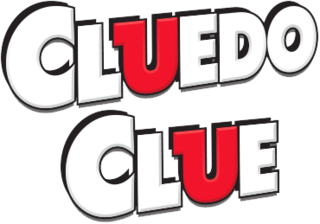
Cluedo, known as Clue in North America, is a murder mystery game for three to six players that was devised in 1943 by British board game designer Anthony E. Pratt. The game was first manufactured by Waddingtons in the United Kingdom in 1949. Since then, it has been relaunched and updated several times, and it is currently owned and published by the American game and toy company Hasbro.
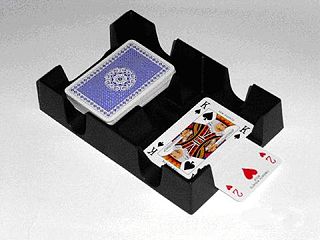
Canasta is a card game of the rummy family of games believed to be a variant of 500 rum. Although many variations exist for two, three, five or six players, it is most commonly played by four in two partnerships with two standard decks of cards. Players attempt to make melds of seven cards of the same rank and "go out" by playing all cards in their hands. It is "the most recent card game to have achieved worldwide status as a classic".

Shithead is a card game, the object of which is to lose all of one's playing cards. There are many regional variations to the game's original rules.

500 rum, also called pinochle rummy, Michigan rummy, Persian rummy, rummy 500 or 500 rummy, is a popular variant of rummy. The game of canasta and several other games are believed to have developed from this popular form of rummy. The distinctive feature of 500 rum is that each player scores the value of the sets or cards they meld. It may be played by 2 to 8 players, but it is best for 3 to 5.

Escape from Colditz is a board game produced by Gibsons Games of London in 1973 that simulates attempted escapes by Allied prisoners-of-war (POWs) from Oflag IV-C during World War II. Designed in part by Pat Reid, a former POW who escaped from Colditz, the game was released during the first run of the popular television series Colditz, and the game likewise proved popular. Licensed editions were published by Parker Brothers and a number of other companies. The game proved especially popular in Spain, and resulted in a Spanish-language sequel.
Wink murder is a party game or parlour game in which a secretly selected player is able to "kill" others by winking at them, while the surviving players try to identify the killer. The game is also variously known as murder wink, killer, murder in the dark, lonely ghost and killer killer. The practical minimum number of players is four, but the spirit of the game is best captured by groups of at least six players or more.
Ulti, or Ultimó, is Hungary's national trick-taking card game for three players. It is virtually unknown outside its home borders.

Switch is a shedding-type card game for two or more players that is popular in the United Kingdom, Ireland and as alternative incarnations in other regions. The sole aim of Switch is to discard all of the cards in one's hand; the first player to play their final card, and ergo have no cards left, wins the game. Switch is very similar to the games Crazy Eights, UNO, Flaps, Mau Mau or Whot! belonging to the Shedding family of card games.
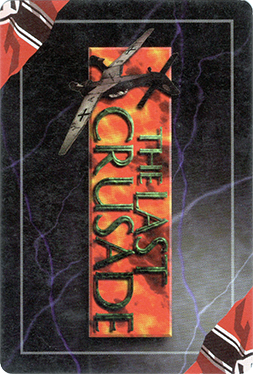
The Last Crusade is an out-of-print collectible card game originally published in December 1995 by Virginia-based Chameleon Eclectic Entertainment until the company closed in early 1999, at which time Pinnacle Entertainment Group took over production.

Outrage!, "the official Tower of London board game", was first created in 1992 by Imperial Games. Players move about the board, which depicts the Tower of London, and attempt to steal the British Crown Jewels. In reality, the only modern attempt to steal the Jewels was made in 1671 by Thomas Blood and his accomplices, who failed to escape — an earlier attempt in the early fourteenth century was equally unsuccessful — and the game challenges players to "succeed where they failed".
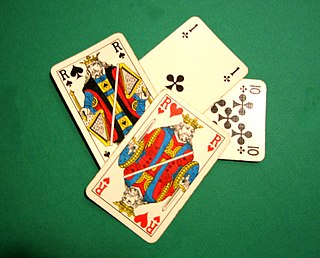
Twenty-eight is an Indian trick-taking card game for four players, in which the Jack and the nine are the highest cards in every suit, followed by ace and ten. It thought to be descended from the game 304, along with similar Indian games known as "29", "40" and "56".

Clue: Parker Brothers' Classic Detective Game is a North American-exclusive video game published for the Super Nintendo Entertainment System and Sega Genesis video game consoles. It is based on the popular board game of the same name.

Last Night on Earth: The Zombie Game is a survival horror board game that was first published in 2007. Players can play on the Hero team or as the Zombies. A modular board randomly determines the layout of the town at the start of each game and there are several different scenarios to play. Seven supplements have been released.

Mystery Mansion is the name of a series of board games in which players search furniture and other objects inside a mansion to locate a hidden treasure or stash of money.
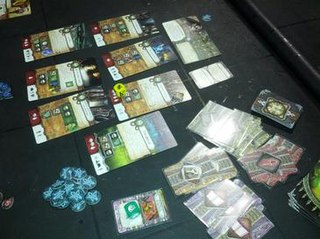
Elder Sign is a cooperative card and dice game, based on the Cthulhu Mythos of horror writer H.P. Lovecraft and Chaosium's Call of Cthulhu roleplaying game. It is published by Fantasy Flight Games, which also produces the Cthulhu Mythos games Arkham Horror, Call of Cthulhu: The Card Game, Mansions of Madness, and Eldritch Horror.
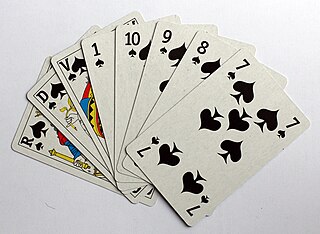
Triomphe, once known as French ruff, is a card game dating from the late 15th century. It most likely originated in France or Spain and later spread to the rest of Europe. When the game arrived in Italy, it shared a similar name with the pre-existing game and deck known as trionfi; probably resulting in the latter becoming renamed as Tarocchi (tarot). While trionfi has a fifth suit that acts as permanent trumps, triomphe randomly selects one of the existing four suits as trumps. Another common feature of this game is the robbing of the stock. Triomphe became so popular that during the 16th century the earlier game of trionfi was gradually renamed tarocchi, tarot, or tarock. This game is the origin of the English word "trump" and is the ancestor of many trick-taking games like Euchre and Whist. The earliest known description of Triomphe was of a point-trick game, perhaps one of the earliest of its type; later, the name was applied to a plain-trick game.
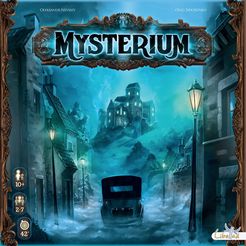
Mysterium is a cooperative board game designed by Oleksandr Nevskiy and Oleg Sidorenko. It blends aspects of murder mystery games and card-based guessing games. One person plays the ghost of a murdered individual who can communicate with the other players only through a series of visions in the form of illustrated cards. The other players, who take the role of psychic mediums, must interpret these cards to identify a suspect, location, and murder weapon. Following its release, Mysterium received positive reviews. It has since received two expansions Mysterium: Hidden Signs and Mysterium: Secrets and Lies, which introduces a new card type to identify: the story.
Cluedo, known as Clue in North America, is a murder mystery-themed multimedia franchise started in 1949 with the manufacture of the Cluedo board game. The franchise has since expanded to film, television game shows, book series, computer games, board game spinoffs, a comic, a play, a musical, jigsaws, card games, and other media.


















